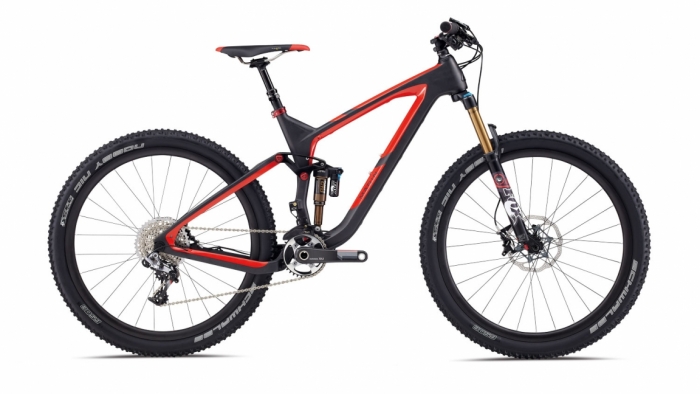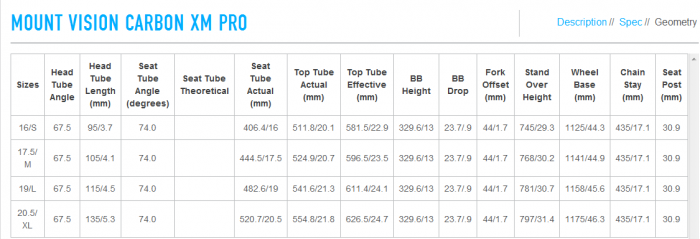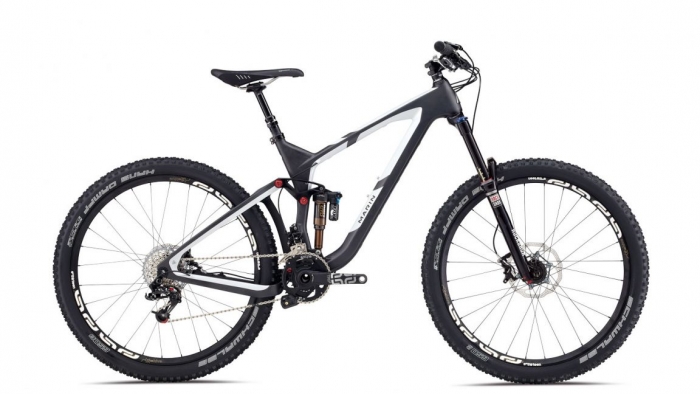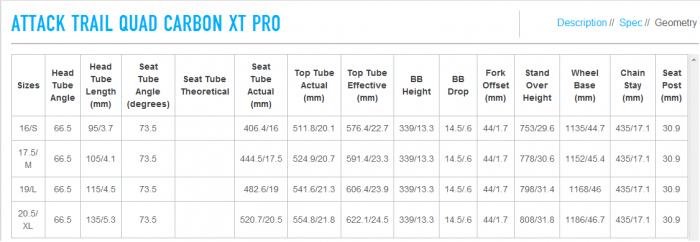BEAR — Marin 2014
Господа, как человека, чьим первым байком был Marin, меня смущает отсутствие линейки велосипедов 2014 года на 26.ру. Спешу исправить сие недоразумение. Итак, встречаем — Mount Vision Carbon XM Pro.

Велосипеды сильно отличаются от велосипедов предыдущего года, и ещё сильнее отличаются от велосипедов 2-х летней давности (к моему огромному сожалению). Что нас ждёт? Полностью карбоновая рама с внутренней прокладкой тросов, 140 мм. хода, карбоновые tubless колёса 27,5", угол рулевой 67,5° и угол подседельной трубы — 74°.
Геометрия Mount Vision:

Линейка Mount Vision представлена 6 байками, 2 алюминиевых и 4 карбоновых (из которых 1 женский).
Следующая линейка — Attack Trail.
Attack Trail Quad Carbon XT Pro.

Здесь уже изменяемый ход 150-160 мм. Quad-link 3.0, всё те же 27,5" колёса, 66,5° — угол рулевой и 73,5° — угол подседельной трубы. Считаю, что получились неплохие байки, с хорошей геометрией. Всего в линейке 3 байка, все полностью карбоновые с внутренней прокладкой кабелей.
Геометрия Attack Trail:


Велосипеды сильно отличаются от велосипедов предыдущего года, и ещё сильнее отличаются от велосипедов 2-х летней давности (к моему огромному сожалению). Что нас ждёт? Полностью карбоновая рама с внутренней прокладкой тросов, 140 мм. хода, карбоновые tubless колёса 27,5", угол рулевой 67,5° и угол подседельной трубы — 74°.
Геометрия Mount Vision:

Линейка Mount Vision представлена 6 байками, 2 алюминиевых и 4 карбоновых (из которых 1 женский).
Следующая линейка — Attack Trail.
Attack Trail Quad Carbon XT Pro.

Здесь уже изменяемый ход 150-160 мм. Quad-link 3.0, всё те же 27,5" колёса, 66,5° — угол рулевой и 73,5° — угол подседельной трубы. Считаю, что получились неплохие байки, с хорошей геометрией. Всего в линейке 3 байка, все полностью карбоновые с внутренней прокладкой кабелей.
Геометрия Attack Trail:

-
добавить в избранное
- +11
- Мнения
Комментировать
Зарегистрируйтесь или авторизуйтесь. Сделайте что-нибудь.


Комментарии (30)
yurtsa
BEAR
Жаль, Марин потерял свою изюминку.
Alessander
velikain
Daniil_Liakhovskiy
Feanor
По поводу цены, лучше спросить Игоря Модина. Но обычно, к нам не доезжают свежие трейловые рамы.
BEAR
im66
aacho
alt
Data_Link
Отряд не заметил подмены бойца :D
nepunk
BEAR
MarinaHumeniuk
allan44
BEAR
allan44
По сути тот же VPP. У меня было 2 марина, Маунт Вижн и Квейк, никаких нареканий к работе подвески и аморта у меня не было. А по поводу VPP и прогрессии, то тут даже Cane Creek говорит, что для некоторых Интенсов и Санта Крузов нужен немного более емкий воздушный амморт. Так что определенные проблемы с прогрессией были не только у Marin.
BEAR
Hello SingleTrackHound,
My intentions for this response are not to critique these other designs, but to (hopefully) help you to understand how the Marin QUAD-Link suspension system works. I’m sure that Santa Cruz, Intense, and Dave Weagle would do a much better job of describing how their suspension designs work than I would, so I’ll keep the response focused on Marin.
The Marin QUAD-Link, VPP, and DW-Link all fall into the same category of suspension, which is true 4-bar linkage. Starting with basic layout, you can see that Marin’s links are all inside the front triangle, with elevated stays on the swingarm. This layout helps to keep the pivot hardware out of the mud/water/dust spray from the rear wheel, and allows us to construct a compact, rigid swingarm structure with tons of rear tire clearance. The placement of the links also allows us to reduce the amount of hardware to only 4-bolts, which capture all 4 pivots and the rear shock. This Patented 4-Bolt/4-Bar layout has the shock eyes pivoting concentrically with the suspension pivots.
The Marin QUAD-Link rear wheel path has the rear wheel moving away from the BB center as it moves up, causing a small amount of chaingrowth up to the suggested sag point. Pedaling forces pull the chain, and in turn drive the wheel into the ground, providing excellent pedaling traction. Past the suggested sag point, the wheelpath changes to zero chaingrowth, which means that any impact that drives the rear wheel past the sag point will not have any effect on pedaling. This allows smooth pedaling through rough terrain.
Because true 4-bar linkage bikes like those you’ve asked about use a multi pivot layout, the rear wheel path cannot be described as an arc. The rear wheel path is a complex curve, defined by a complicated mathematical equation. However, for practical purposes, the “VPP” or “Instantaneous Pivot Center” (IPC) can be located by drawing a line through each link, right through the pivots, until the lines intersect (see images) This intersection is the IPC, and that IPC location changes constantly throughout the suspensions travel. It is the behavior of the IPC that differs between the Marin QUAD-Link, VPP, and DW bikes.
With the Marin, the IPC starts in front of, and above the bottom bracket. As the suspension moves through its travel the IPC swings down, and toward the bottom bracket, finishing in front of, but below the bottom bracket. Because the IPC moves closer to the center of the rear wheel, the swingarm is effectively getting shorter. In terms of leverage, this means that the QUAD-Link has a “Rising Rate” suspension. On the trail that means small trail imperfections are met with minimal resistance, but the Marin QUAD-Link system automatically adjusts it’s leverage ratio for larger hits, giving a feel that has often been described as “bottomless”.
All of these characteristics are tweaked for different bikes; where on a 100mm Alchemist the focus is on pedaling efficiency and climbing traction, the Quake is tuned for terrain management, and impact absorption.
I know this all sounds complicated, so I suggest you see your LBS for a test ride. It will all make more sense then.
I hope this helps.
Jason
Marin Bikes
взято с forums.mtbr.com/marin/how-does-marin-quad-link-differ-vpp-dw-link-437886.html
BEAR
allan44
BEAR
2 — пипл не хавал
теперь хавает.
djatell
im66
djatell
Говорю за Волф Ридж
Alessander
im66
Knolly
VladimirDolgin
Интересное решение для 140 мм…
GAAff
RomanAkentev